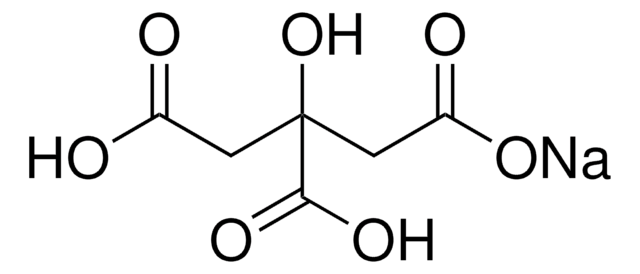C8532
Sodium citrate tribasic dihydrate
for molecular biology, ≥99%
Synonym(s):
Citric acid trisodium salt dihydrate, Trisodium citrate dihydrate
About This Item
Recommended Products
grade
for molecular biology
Quality Level
Assay
≥99%
form
powder
pH
7.5-9 (25 °C, 29.4 g/L)
mp
>300 °C (lit.)
solubility
water: soluble 100 mg/mL
foreign activity
DNAse, none detected
Endonuclease, none detected
Exonuclease, none detected
NICKase, none detected
Protease, none detected
RNAse, none detected
SMILES string
O.O.[Na+].[Na+].[Na+].OC(CC([O-])=O)(CC([O-])=O)C([O-])=O
InChI
1S/C6H8O7.3Na.2H2O/c7-3(8)1-6(13,5(11)12)2-4(9)10;;;;;/h13H,1-2H2,(H,7,8)(H,9,10)(H,11,12);;;;2*1H2/q;3*+1;;/p-3
InChI key
NLJMYIDDQXHKNR-UHFFFAOYSA-K
Looking for similar products? Visit Product Comparison Guide
Related Categories
General description
Application
- to perform antibody retrieval for the immunohistochemical analysis of ovine ovarian sections
- as a component of induction medium to culture Agrobacterium strain C58C1
- to isolate human neutrophils from whole blood
Storage Class Code
11 - Combustible Solids
WGK
WGK 1
Flash Point(F)
Not applicable
Flash Point(C)
Not applicable
Personal Protective Equipment
Choose from one of the most recent versions:
Already Own This Product?
Find documentation for the products that you have recently purchased in the Document Library.
Customers Also Viewed
Our team of scientists has experience in all areas of research including Life Science, Material Science, Chemical Synthesis, Chromatography, Analytical and many others.
Contact Technical Service



